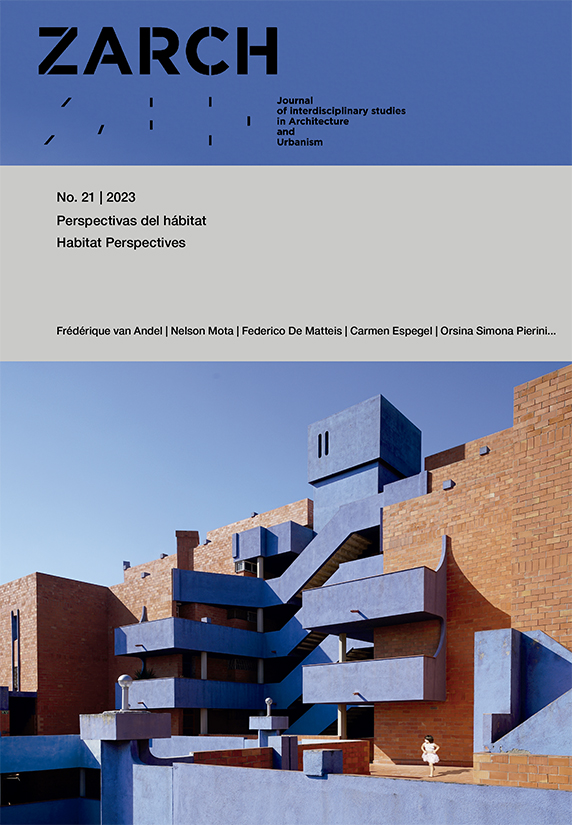Lessons from Metabolism. Evolution of Built Legacy on Continuous Change
DOI:
https://doi.org/10.26754/ojs_zarch/zarch.2023218933Keywords:
Metabolism, Adaptability, Megastructure, Collective Form, Nakagin Tower, Hillside TerraceAbstract
One of the most prolific and inspiring offshoots of the utopian architecture of the 1960s, Metabolism, still offers valuable lessons for current urban development. Among the members of the Japanese group, two positions on the design of architecture and the city can be distinguished: one advocating the megastructural scheme and the other based on the logic of the collective or group-form, more akin to the structuralist approach. Both emerged around the same principle: the adaptability of architecture in the face of change over time, but offered different responses, some of which saw the light of day off paper in the 1970s. After half a century, this article studies the evolutionary development of two projects belonging to both factions: Kisho Kurokawa's Nakagin Capsule Tower and Fumihiko Maki's Hillside Terrace, with the dual aim of testing the extent to which the theory of transformation and constant growth was put into practice and of drawing useful lessons for a contemporary practice that increasingly seeks resilience in the face of changing events and conditions.
Downloads
References
Banham, Reyner. Megastructure: Urban Futures of the Recent Past. Nueva York: Harper & Row, 1976.
Coelho, Joao Rodrigo. A few notes to (re) think the design of public space in the contemporary city. ZARCH: Journal of Interdisciplinary studies in Architecture and Urbanism 2 (2013): 42-51.
De Solà-Morales, Manuel. La segunda historia del proyecto urbano. UR: urbanismo revista 5 (1987): 21-27.
De Solà-Morales, Manuel; Frampton, Kenneth; Ibelings, Hans. De cosas urbanas. Barcelona: Gustavo Gili, 2008.
Fernández Per, Aurora; Mozas Lérida, Javier; Sanz Ollero, Alejandro. 10 Historias Sobre Vivienda Colectiva: Análisis Gráfico De Diez Obras Esenciales. Vitoria-Gasteiz: A+T, 2013.
Flores Soto, José Antonio. Nakagin Capsule Tower: la arquitectura convertida en signo. El Genio Maligno, Revista de Humanidades y Ciencias Sociales 20 (2017): 1-11.
Geddes, Patrick. Cities in evolution: an introduction to the town planning movement and to the study of civics. Londres, Williams, 1915.
Genadt, Ariel. Three Lessons from Japan on Architectural Resilience. Architectural Histories 7.1 (2019): 1-16.
Habraken, Nicolaas John; Ramón, Fernando. Soportes: una alternativa al alojamiento de masas. Alberto Corazón, 1975.
Ishida, Aki. Paradox of a Landmark that is not: the life of the Nakagin Capsule Tower. International Conference on East Asian Architectural Culture (2015): 105-110.
Kamei, Yasuko. The spatial composition of the Daikanyama Hillside Terrace Building Complex as observed through its Layers of Permeable Space. The visualization and quantification of the okusei of space. 日本建築学会技術報告集 29.71 (2023): 412-417.
Kurokawa, Kisho. Metabolism in architecture. Londres: Studio Vista, 1977.
Lin, Zhongjie. Kenzo Tange and the Metabolist Movement: Urban Utopias of Modern Japan. Routledge, 2010.
Lin, Zhongjie. Nakagin Capsule Tower: Revisiting the Future of the Recent Past. Journal of architectural education 65.1 (2011): 13-32.
Maeda, Tatsuyuki; Yoshida, Yuka. The real reason why Nakagin Capsule Tower was never metabolized. docomomo journal 65 (2021): 118-120.
Maki, Fumihiko. Investigations in Collective Form. Washington University, 1964.
_____. My urban design of fifty years. Ekistics (2006): 26-38.
_____. Nurturing Dreams: Collected Essays on Architecture and the City. MIT Press, 2012.
_____. On Collective Form. docomomo journal 53 (2015): 4-11.
_____. The Future of Urban Environment. Progressive Architecture 45 (octubre 1964): 178.
Merino del Río, Rebeca; Grijalba Bengoetxea, Julio; Grijalba Bengoetxea, Alberto. Paisajes urbanos. El edificio como una ciudad. Central Beheer. ZARCH: Journal of Interdisciplinary studies in Architecture and Urbanism 7 (2016): 144-157.
Palacios Labrador, Luis. Hacia un método de configuración: Van Eyck/Blom/Hertzberger. Iniciadores y sucesores. Tesis Doctoral. Departamento de Proyectos Arquitectónicos, Escuela Técnica Superior de Arquitectura de Madrid, 2017.
Paul, René. Hillside Terrace in Tokyo, 1967-1992: Architekt: Fumihiko Maki & Assoc. Werk, Bauen + Wohnen 79.12 (1992): 49-53.
Sant’Elia, Antonio. 1914 Antonio Sant'Elia: Manifesto of Futurist Architecture 1. En Rethinking Technology: A Reader in Architectural Theory, eds. William W. Braham y Jonathan A. Hale, 15-18. Routledge, 2006.
Song, Hayub; Jeon, You-Chang; Yoon, Sunghoon. Inner Space in the City: Jose Luis Sert, Fumihiko Maki and Kyu Seung Woo′ s Search for Inner Space. Journal of Asian Architecture and Building Engineering 14.2 (2015): 233-240.
Tamari, Tomoko. Metabolism: Utopian Urbanism and the Japanese Modern Architecture Movement. Theory, Culture & Society 31.7-8 (2014): 201-225.
Vives Rego, Javier. Arquitectura moderna de Japón. Satori, 2019.
Yamazaki, Rima. Kisho Kurokawa: la Torre Cápsula de Nakagin. Barcelona: Fundación Caja de Arquitectos, 2013. DVD.


